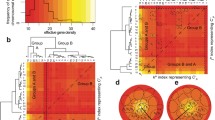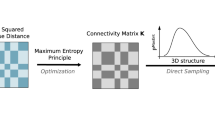Abstract
Interphase chromosomes are organized into discrete chromosome territories (CTs) that may occupy preferred sub-nuclear positions. While chromosome size and gene density appear to influence positioning, the biophysical mechanisms behind CT localization, especially the relationship between morphology and positioning, remain obscure. One reason for this has been the difficulty in imaging, segmenting, and analyzing structures with variable or imprecise boundaries. This prompted us to develop a novel approach, based on the two-dimensional (2D) wavelet-transform modulus maxima (WTMM) method, adapted to perform objective and rigorous CT segmentation from nuclear background. The wavelet transform acts as a mathematical microscope to characterize spatial image information over a continuous range of size scales. This multiresolution nature, combined with full objectivity of the formalism, makes it more accurate than intensity-based segmentation algorithms and more appropriate than manual intervention. Using the WTMM method in combination with numerical simulation models, we show that CTs have a highly nonspherical 3D morphology, that CT positioning is nonrandom, and favors heterologous CT groupings. We discuss potential relationships between morphology, positioning, chromosomal function, and instability.
Similar content being viewed by others
References
Arneodo A, Bacry E, Muzy JF (1995) The thermodynamics of fractals revisited with wavelets. Physica 213A: 232–275.
Arneodo A, Decoster N, Roux S (2000) A wavelet-based method for multifractal image analysis. I. Methodology and test applications on isotropic and anisotropic random rough surfaces. Eur Phys J B 15: 567–600.
Arneodo A, Decoster N, Kestener P, Roux SG (2003) A wavelet-based method for multifractal image analysis: from theoretical concepts to experimental applications. Adv Imaging Electron Phys 126: 1–92.
Bickmore WA, Teague P (2002) Influences of chromosome size, gene density and nuclear position on the frequency of constitutional translocations in the human population. Chromosome Res 10: 707–715.
Bolzer A, Kreth G, Solovei I et al. (2005) Three-dimensional maps of all chromosomes in human male fibroblast nuclei and prometaphase rosettes. PLoS Biol 3: e157
Bornfleth H, Satzler K, Eils R, Cremer C (1998) High-precision distance measurements and volume-conserving segmentation of objects near and below the resolution limit in three-dimensional confocal fluorescence microscopy. J Microsc 189: 118–136.
Boyle S, Gilchrist S, Bridger JM, Mahy NL, Ellis JA, Bickmore WA (2001) The spatial organization of human chromosomes within the nuclei of normal and emerin-mutant cells. Hum Mol Genet 10: 211–219.
Branco MR, Pombo A (2006) Intermingling of chromosome territories in interphase suggests role in translocations and transcription-dependent associations. PLOS Biol 4: e138.
Canny J (1986) A computational approach to edge detection. IEEE Trans Pat Ana Mach Intell 36: 961–1005.
Chaikin PM, Donev A, Man W, Stillinger FH, Torquato S (2006) Some observations on the random packing of hard ellipsoids. Ind Eng Chem Res 45: 6960–6965.
Cornforth MN, Greulich-Bode KM, Loucas BD et al. (2002) Chromosomes are predominantly located randomly with respect to each other in interphase human cells. J Cell Biol 159: 237–244.
Cremer T, Cremer C (2001) Chromosome territories, nuclear architecture and gene regulation in mammalian cells. Nat Rev Genet 2: 292–301.
Cremer T, Cremer M, Dietzel S, Müller S, Solovei I, Fakan S (2006) Chromosome territories—a functional nuclear landscape. Curr Opin Cell Biol 3: 307.
Cremer T, Kreth G, Koester H et al. (2000) Chromosome territories, interchromatin domain compartment, and nuclear matrix: an integrated view of the functional nuclear architecture. Crit Rev Eukaryot Gene Expr 10: 179–212.
Cremer M, Kupper K, Wagler B et al. (2003) Inheritance of gene density-related higher order chromatin arrangements in normal and tumor cell nuclei. J Cell Biol 162: 809–820.
Cremer M, von Hase J, Volm T et al. (2001) The non-random radial higher-order chromatin arrangements in nuclei of diploid human cells. Chromosome Res 9: 541–567.
Croft JA, Bridger P, Boyle S, Perry JM, Teague P, Bickmore WA (1999) Differences in the localization and morphology of chromosomes in the human nucleus. J Cell Biol 145: 1119–1131.
Csink AK, Henikoff S (1998) Large-scale chromosomal movements during interphase progression in drosophilia. J Cell Biol 143: 13–22.
Donev A, Cisse I, Sachs D et al. (2004) Improving the density of jammed disorded packings using ellipsoids. Science 303: 990–993.
Dundr M, Misteli T (2001) Functional architecture in the cell nucleus. Biochem J 356: 297–310.
Edelmann P, Bornfleth H, Zink D, Cremer T, Cremer C (2001) Morphology and dynamics of chromosome territories in living cells. Biochim Biophys Acta 1551: 29–40.
Eils R, Dietzel S, Bertin E et al. (1996) Three-dimensional reconstruction of painted human interphase chromosomes: active and inactive X chromosome territories have similar volumes but differ in shape and surface structure. J Cell Biol 135: 1427–1440.
Gerlich D, Beaudouin J, Kalbfuss B, Daigle N, Eils R, Ellenberg J (2003) Global chromosome positions are transmitted through mitosis in mammalian cells. Cell 112: 751–764.
Gilbert N, Gilchrist S, Bickmore WA (2005) Chromatin organization in the mammalian nucleus. Int Rev Cytol 242: 283–336.
Gue M, Messaoudi C, Sheng Sun J, Boudier T (2005) Smart 3D-FISH: automation of distance analysis in nuclei of interphase cells by image processing. Cytometry Part A 67A: 18–26.
Habermann FA, Cremer M, Walter J et al. (2001) Arrangements of macro- and microchromosomes in chicken cells. Chromosome Res 9: 569–584.
Kestener P, Arneodo A (2003) Three-dimensional wavelet-based multifractal method: the need for revisiting the multifractal description of turbulence dissipation data. Phys Rev Lett 91: 194501.
Khalil A, Joncas G, Nekka F (2004) Morphological analysis of HI features. I. Metric space technique. Astrophys J 601: 352–364.
Khalil A, Joncas G, Nekka F, Kestener P, Arneodo A (2006) Morphological analysis of HI features. II. Wavelet-based multifractal formalism. Astrophys J Suppl Ser 165: 512–550.
Kreth G, Finsterle J, von Hase J, Cremer M, Cremer C (2004) Radial arrangement of chromosome territories in human cell nuclei: a computer model approach based on gene density indicates a probabilistic global positioning code. Biophys J 86: 2803–2812.
Kurz A, Lampel S, Nickolenko JE et al. (1996) Active and inactive genes localize preferentially in the periphery of chromosome territories. J Cell Biol 135: 1195–1205.
Mallat S (1998) A Wavelet Tour in Signal Processing. New York: Academic Press.
Mayer R, Brero A, von Hase J, Schroeder T, Cremer T, Dietzel S (2005) Common themes and cell type specific variations of higher order chromatin arrangements in the mouse. BMC Cell Biol 6: 44.
Meaburn KJ, Misteli T (2007) Cell biology: chromosome territories. Nature 445: 379–781.
Muzy JF, Bacry E, Arneodo A (1991) Wavelets and multifractal formalism for singular signals: application to turbulence data. Phys Rev Lett 67: 3515–3518.
Muzy JF, Bacry E, Arneodo A (1994) The multifractal formalism revisited with wavelets. Int J Bifurcation Chaos 4: 245–302.
Otsu N (1979) A threshold selection method from gray level histograms. IEEE Trans Syst Man Cybernet 9: 62–66.
Parada LA, McQueen PG, Misteli T (2004) Tissue-specific spatial organization of genomes. Genome Biol 5: R44.
Parada LA, McQueen PG, Munson PJ, Misteli T (2002) Conservation of relative chromosome positioning in normal and cancer cells. Curr Biol 12: 1692–1697.
Parada LA, Misteli T (2002) Chromosome positioning in the interphase nucleus. Trends Cell Biol 12: 425–432.
Roix JJ, McQueen PG, Munson PJ, Parada LA, Misteli T (2003) Spatial proximity of translocation prone gene loci in human lymphomas. Nat Genet 34: 287–291.
Sharon E, Galun M, Sharon D, Basri R, Brandt A (2006) Hierarchy and adaptivity in segmenting visual scenes. Nat Lett 442: 810–813.
Shopland LS, Lynch CR, Peterson KA et al. (2006) Folding and organization of a contiguous chromosome region according to the gene distribution pattern in primary genomic sequence. J Cell Biol 174: 27–38.
Solovei I, Cavallo A, Schermelleh L et al. (2002) Spatial preservation of nuclear chromatin architecture during three-dimensional fluorescence in situ hybridization (3D-FISH). Exp Cell Res 276: 10–23.
Stadler S, Schnapp V, Mayer R et al. (2004) The architecture of chicken chromosome territories changes during differentiation. BMC Cell Biol 5: 44.
Thomson I, Gilchrist S, Bickmore WA, Chubb JR (2004) The radial positioning of chromatin is not inherited through mitosis but is established de novo in early G1. Curr Biol 14: 166–172.
Visser AE, Eils R, Jauch A et al. (1998) Spatial distributions of early and late replicating chromatin in interphase chromosome territories. Exp Cell Res 243: 398–407.
Weierich C, Brero A, Stein S et al. (2003) Three-dimensional arrangements of centromeres and telomeres in nuclei of human and murine lymphocytes. Chromosome Res 11: 485–502.
Zinc D, Bornfleth H, Visser A, Cremer C, Cremer T (1999) Organization of early and late replicating DNA in human chromosome territories. Exp Cell Res 247: 176–188.
Author information
Authors and Affiliations
Corresponding author
Electronic Supplementary Material
Below is the image is a link to a high resolution version
Supplemental Figure 1
Representation of an x–z view of the simulated nucleus used for both random models. Both poles of the nucleus have been flattened, by the slide and the cover slip respectively. This representation is obtained by taking the intersection between a sphere and two intersecting planes. The distance between the two planes is 3/4 the diameter of the sphere. (GIF 37.1 KB)
Supplemental Figure 2
Top row: First-order wavelet filtering of a pure (white) noise image shown in (A) at three increasing scales (B, C, and D), showing that no correlated structure appears. Bottom row: Same as above, but with the noisy image taken from main text Figure 5G with a ‘hidden’ cell nucleus with two chromosome territories, showing that the CT structure clearly appears at larger scales (H) and then can be followed across scales (G, F), thus illustrating how the WTMM method can detect such hidden objects through its multiresolution analysis (main text Figure 5). (GIF 506 KB)
Supplemental Figure 3
Example of a chromosome 15 image (A) for which the first-order wavelet algorithm failed to detect the lower left CT but the third-order wavelet algorithm succeeded (B). (GIF 30 KB)
Rights and permissions
About this article
Cite this article
Khalil, A., Grant, J.L., Caddle, L.B. et al. Chromosome territories have a highly nonspherical morphology and nonrandom positioning. Chromosome Res 15, 899–916 (2007). https://doi.org/10.1007/s10577-007-1172-8
Received:
Revised:
Accepted:
Published:
Issue Date:
DOI: https://doi.org/10.1007/s10577-007-1172-8




